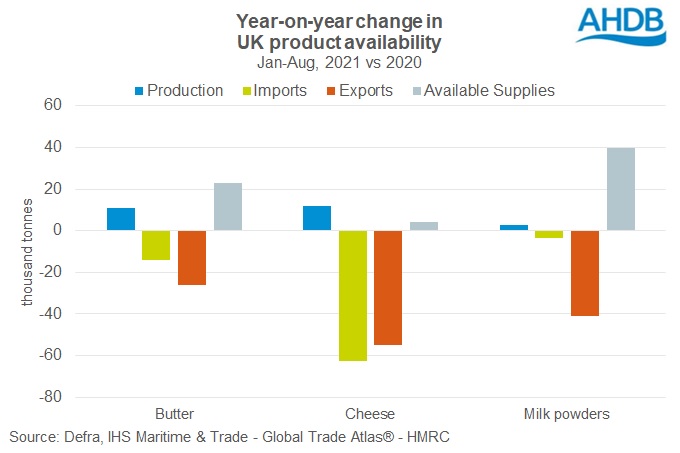UK dairy product availability sees only limited growth
Wednesday, 27 October 2021
By Patty Clayton
The past year has seen big changes in how the UK trades, shaped by our exit from the EU trading bloc and the impacts of the pandemic. This has played a role in how dairy product availability[1] has developed so far this year (Jan-Aug).
Both butter and cheese have seen small increases in production volumes in the Jan-Aug period compared to 2020. While milk deliveries increased only marginally over the 8-month period (+0.5%), less was allocated to both the liquid milk market and the production of yogurt.
For butter, the reduction in both imports and exports has led to a marginal year on year increase in available supplies. Exports of butter (Jan-Aug) were almost 10,000 tonnes lower than in the same period last year. At the same time, imports have dropped by just under 16,000 tonnes, limiting growth in available volumes for the domestic market to just 5,000 tonnes.
With cheese, we have seen a similar situation, although exaggerated. As a net importer of cheese, the 21% drop in imports (67,000 tonnes) had a big impact on availability, despite sending 26,000 tonnes less product overseas. Overall, available supplies have dropped by 6%, or almost 30,000 tonnes, in comparison to the position at the same time last year.
Available supplies of milk powders are up year on year, a direct result of lower exports. Both production and imports are at similar levels to the comparable period in 2020.

It is unclear how much of these stocks are already earmarked for sale or waiting for export once shipping becomes available. However, with retail sales remaining strong for both butter and cheese, and foodservice demand gradually returning, the limited growth in availability will likely put pressure on the markets. This pressure can of course be relieved through increased imports. However, with EU milk production struggling to meet internal demand, and shipping costs skyrocketing, imports are likely to only offer limited relief.
[1] Availability is defined as production + imports – exports. It does not measure stocks as sales levels cannot be measured
Sign up to receive the latest information from AHDB.
While AHDB seeks to ensure that the information contained on this webpage is accurate at the time of publication, no warranty is given in respect of the information and data provided. You are responsible for how you use the information. To the maximum extent permitted by law, AHDB accepts no liability for loss, damage or injury howsoever caused or suffered (including that caused by negligence) directly or indirectly in relation to the information or data provided in this publication.
All intellectual property rights in the information and data on this webpage belong to or are licensed by AHDB. You are authorised to use such information for your internal business purposes only and you must not provide this information to any other third parties, including further publication of the information, or for commercial gain in any way whatsoever without the prior written permission of AHDB for each third party disclosure, publication or commercial arrangement. For more information, please see our Terms of Use and Privacy Notice or contact the Director of Corporate Affairs at info@ahdb.org.uk © Agriculture and Horticulture Development Board. All rights reserved.

